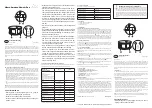
M
IDIAN
E
LECTRONICS
I
NCORPORATED
P
AGE
11
DDU-100/200
Manual
becomes active for the Squelch Output to go inactive.
This allows the Squelch Output to be used to mute
incoming ANI's if connected to a point which disables
the radio speaker. This value should be set to allow for
any key-up delay of the transmitting unit as well as the
time it takes for the ANI to complete.
Range:
0000 to 4000 milliseconds
Default:
0300
milliseconds
5.5.5.6 Trunk Delay Polarity setting
When using with trunked radios, this setting
determines the active state of the Trunking Delay Input
(a.k.a. LTR in). This input is used to hold-off
transmitting a call until a channel is acquired on the
trunking system. If a channel is not acquired within 4.5
seconds, a timeout will occur and the call will be
canceled.
Important note:
The Trunking Delay Input
shares the same wire as the Squelch Output. Normally
the wire acts as the Squelch Output. The DDU must be
jumpered correctly to configure this wire for trunking.
Please see the installation instructions.
When not using the Trunking Delay Input, this setting
should be HIGH.
LOW
Trunking signal goes to 0V when a
channel is acquired.
HIGH
Trunking signal goes to 5V when a
channel is acquired.
5.5.6 ENC/DEC SETUP menu
5.5.6.1 Encode Format setting
The tone-signaling format used to encode outgoing
calls. Select from one of the following formats:
DTMF
CCIR
EEA
EIA
ZVEI
DZVEI
DDZVEI
NATEL
MODAT
5.5.6.2 Encode Time 1 setting
When using 5-tone formats (non-DTMF):
The
amount of time for the
first
tone (or digit) of the encode
sequence (may also be a preamble). This is also
known as
tone width
. Each ANI format has standard
tone widths. Non-standard tone widths are permitted,
allowing for faster encode.
When using DTMF format:
This is the tone ON time
for DTMF format.
Range:
0005 to 1000 milliseconds
Default:
0050
milliseconds
5.5.6.3 Encode Time 2 setting
When using 5-tone formats (non-DTMF):
This is the
duration of each of the
remaining
tones (or digits) of
the encode sequence. Normally, this should be the
same as
Encode Time 1
.
When using DTMF format:
This is the tone OFF time
(between digits) when using DTMF format.
Range:
0005 to 1000 milliseconds
Default:
0050
milliseconds
5.5.6.4 Decode Format setting
The tone-signaling format of the incoming ANI's. The
Encode and Decode formats may be different if
desired. Select from one of the following formats:
DTMF
CCIR
EEA
EIA
ZVEI
DZVEI
DDZVEI
NATEL
MODAT
5.5.6.5 Decode Time setting
When using 5-tone formats (non-DTMF):
The
minimum amount of time a single tone must be present
before it is decoded. This time can be as little as 5
milliseconds. This time should be set between 1/2 and
1/5
th
of the e
ncode timing
. For example, if the encode
timing is 50 milliseconds per digit, then the Decode
Time should be set between 5 and 25 milliseconds.
The lower the number, the more sensitive the unit will
be. When the number is higher, the unit will be less
susceptible to falsing on noise.
When using DTMF format:
The amount of time after
the last digit is received for decode to take place. This
value should be at least twice that of the digit OFF
time.
Range:
0005 to 9999 milliseconds
Default:
1000
milliseconds
5.5.6.6 Ignore Nonuser option
Turning on this option helps prevent the display of false
decodes by ignoring ID’s which do not appear in the
user database. This can also be used to restrict access
to a repeater to only those ID’s in the database. See
REPEATER SETUP
for more information.
OFF
Display ID’s not in database.








































